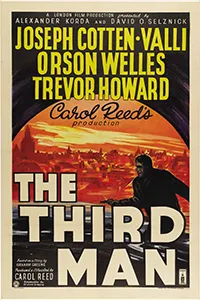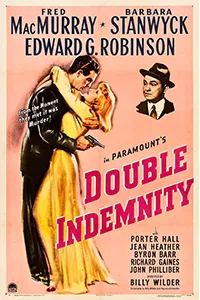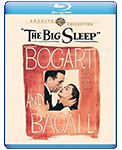THE BIG SLEEP
The Big Sleep is a 1946 film adaptation of Raymond Chandler’s classic novel of the same name. Directed by Howard Hawks, the movie stars Humphrey Bogart as private detective Philip Marlowe and Lauren Bacall as Vivian Rutledge. The film is widely considered a masterpiece of the film noir genre and is known for its stylish visuals, memorable dialogue, and complex plot.
PLOT
The Big Sleep is complex and can be difficult to follow, with multiple subplots and a large cast of characters. However, at its core, the film tells the story of private detective Philip Marlowe (Humphrey Bogart) as he investigates a blackmail scheme involving the wealthy and eccentric General Sternwood (Charles Waldron) and his two daughters, Carmen (Martha Vickers) and Vivian (Lauren Bacall).
The film begins with Marlowe meeting with General Sternwood, who asks him to investigate a blackmail attempt against Carmen, who has been photographed in compromising situations with a local bookstore owner named Geiger. Marlowe agrees to take the case, and his investigation leads him to Geiger’s house, where he finds Carmen drugged and disoriented, and Geiger dead.
Marlowe soon discovers that Geiger was involved in a pornography ring, and that Carmen’s photographs were just one part of a larger scheme. As Marlowe digs deeper into the case, he finds himself entangled in a web of corruption, violence, and deceit involving gangsters, con men, and femme fatales.

One of the key subplots of the film involves Marlowe’s relationship with Vivian Rutledge, General Sternwood’s older daughter. Vivian is initially dismissive of Marlowe, but the two quickly develop a flirtatious rapport. However, Vivian’s involvement in the case becomes increasingly complicated, as she reveals that she is being blackmailed by a man named Eddie Mars (John Ridgely), who is connected to Geiger’s pornography ring.
As the plot thickens, Marlowe finds himself facing multiple threats, including attempts on his life by hired thugs, as he tries to unravel the tangled web of corruption and deceit that surrounds him. The climax of the film involves a shootout at a remote cabin in the woods, where Marlowe confronts the mastermind behind the blackmail scheme and reveals the truth behind the various subplots and conspiracies that have been driving the plot.
The film’s convoluted plot and enigmatic characters are a testament to the genre’s fascination with ambiguity, moral ambiguity, and human frailty.
VISUAL STYLE
The visual style is a significant aspect of the film’s lasting impact and appeal. Here are a few key elements of the film’s visual style:
Lighting: The film makes extensive use of dramatic lighting, with deep shadows and pools of light creating a sense of mystery and danger. The film’s cinematographer, Sidney Hickox, was known for his skill at creating expressive lighting effects, and “The Big Sleep” is a masterclass in his approach.
Camera Movement: The film’s camera work is notable for its fluidity and dynamism, with the camera often tracking and panning to create a sense of movement and energy. This approach helps to maintain the film’s momentum and adds a sense of urgency to the story.
Set Design: The film’s sets are often lavish and detailed, with a particular emphasis on creating a sense of opulence and wealth. The art direction and set design contribute to the film’s sense of glamour and intrigue.
Costume Design: The film’s costume design is also notable, with the characters’ clothing helping to define their personalities and social status. Lauren Bacall’s slinky gowns and Humphrey Bogart’s sharp suits are particularly memorable.
Visual Metaphors: The film makes use of visual metaphors to underscore its themes and create meaning. For example, the film’s use of mirrors and reflections serves to emphasize the duplicity and deception of its characters.
Overall, “The Big Sleep” is a masterclass in film noir visual style, with its use of dramatic lighting, camera movement, set and costume design, and visual metaphors creating a rich and immersive world for the audience to explore.
RECEPTION
The film was not nominated for any Academy Awards, but it was a critical and commercial success upon its release in 1946. Despite the lack of Oscar recognition, the film has become a classic of the film noir genre and is widely regarded as one of the greatest films of all time.
In addition to its lasting critical and cultural impact, “The Big Sleep” was also a significant box office success, grossing over $4 million at the box office and cementing the popularity of its stars, Humphrey Bogart and Lauren Bacall.
Today, the film is remembered not only for its stylish visuals, memorable dialogue, and complex plot but also for the on-screen chemistry between Bogart and Bacall, who would go on to become one of Hollywood’s most iconic couples. The film’s influence can be seen in countless subsequent films and television shows.
THEMES
The Big Sleep explores a number of themes relevant to the era in which it was made:
Corruption
The film portrays a world in which corruption is rampant, with many of the characters being involved in illegal activities such as blackmail, gambling, and pornography. The film suggests that even those in positions of power, such as the police and the wealthy elite, are not immune to corruption.
Sexuality
The film features several sexually suggestive scenes and innuendos, as well as a number of femme fatale characters who use their sexuality to manipulate and control the male protagonists. The film’s exploration of sexuality reflects the changing attitudes toward sex and gender roles that were taking place in postwar America.

Moral ambiguity
The film’s characters are often morally ambiguous, with many of them engaging in actions that are morally questionable or outright criminal. The protagonist, Philip Marlowe, is himself a flawed character, who is willing to engage in violence and deceit in order to achieve his goals.
Femme fatales
The film features several female characters who are portrayed as dangerous and seductive, using their sexuality to manipulate and control men. These femme fatales are often more powerful than the male characters, and they are not always punished for their actions.
Class and social hierarchy
The film portrays a world in which social class and wealth are important factors in determining power and influence. The wealthy elite are shown to have a great deal of power and control over the lives of those beneath them, while the poor and working-class characters are often marginalized and powerless.
The futility of justice
The film suggests that justice is often elusive in a corrupt world, with the police and legal system being ineffective at combating crime and corruption. Marlowe’s investigations often lead to dead ends, and the film ultimately suggests that justice is often arbitrary and elusive.
POPULAR CULTURE
The Big Sleep has had a significant impact on popular culture, both in its own time and in the decades since its release. Here are a few examples:
Parodies and Homages: The film has been parodied and referenced in numerous films, television shows, and other forms of popular culture. Examples include the 1998 film “The Big Lebowski,” which parodies the film’s convoluted plot and hardboiled dialogue, and the television series “Twin Peaks,” which pays homage to the film’s atmospheric visuals and mysterious storyline.
Merchandise: The film has spawned a variety of merchandise, including posters, t-shirts, and other collectibles. These items often feature iconic images from the film, such as Humphrey Bogart and Lauren Bacall in a romantic embrace.
Film Noir Revival: “The Big Sleep” is often cited as a classic example of the film noir genre, which has enjoyed a revival in recent years. Many contemporary films and television shows, such as “Chinatown” and “True Detective,” draw inspiration from the film’s themes and visual style.
Cultural Significance: “The Big Sleep” is widely regarded as one of the greatest films of all time and is considered a cultural touchstone of the film noir genre. The film’s influence can be seen in countless subsequent works of popular culture, and it remains a popular subject of critical analysis and academic study.
Explore more Film Noir

A legendary film noir featuring Humphrey Bogart as a private detective caught up in a deadly game of deception and greed.

This classic film noir follows private detective Philip Marlowe as he investigates a complex case involving a wealthy family.

A gripping film noir about a seductive woman who convinces an insurance salesman to plot a murder.
